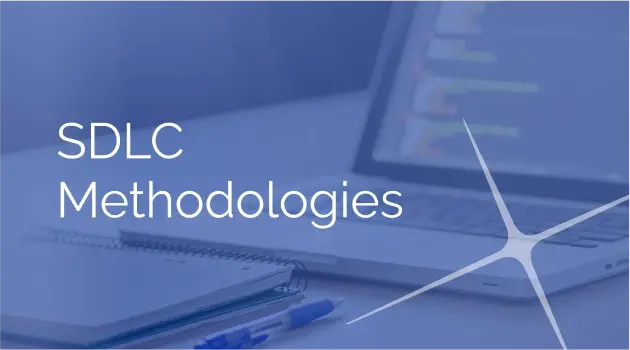
In the realm of software development, having a structured and well-defined approach is essential for delivering high-quality products efficiently. This is where Software Development Life Cycle (SDLC) methodologies come into play. SDLC methodologies provide a systematic framework for managing the entire software development process, from inception to delivery. In this article, we will explore some of the top SDLC methodologies, their key features, and how they can be applied to various projects.
Waterfall Methodology
The Waterfall methodology is one of the oldest and most traditional SDLC approaches. It follows a linear and sequential process, where each phase of development is completed before moving on to the next. The key stages include requirements gathering, design, implementation, testing, deployment, and maintenance. This methodology is well-suited for projects with stable and well-defined requirements, where changes are unlikely to occur.
Pros:
- Easy to understand and manage.
- Clear documentation at each stage.
- Suitable for projects with well-defined requirements.
Cons:
- Lack of flexibility to accommodate changes.
- Limited client involvement until the end.
- Long development cycles can delay product delivery.
Agile Methodology
Agile methodology is an iterative and collaborative approach that emphasizes adaptability and customer collaboration. It focuses on delivering functional software in short iterations called sprints, typically lasting one to four weeks. Agile methodologies, such as Scrum and Kanban, promote frequent communication, flexibility, and continuous improvement.
Pros:
- Allows for flexibility and adaptability.
- Promotes customer collaboration and feedback.
- Early and frequent delivery of working software.
Cons:
- May require more client involvement and time commitment.
- Can be challenging for large-scale projects.
- Lack of detailed documentation may lead to confusion.
Lean Development
Originating from the Lean manufacturing principles, Lean Development aims to eliminate waste and maximize value in software development. It emphasizes delivering the minimum viable product (MVP) with essential features to gather feedback and iterate quickly. Lean Development focuses on continuous improvement and reducing non-value-added activities.
Pros:
- Efficient use of resources and time.
- Early feedback and iteration opportunities.
- Minimization of unnecessary features.
Cons:
- Limited focus on long-term planning.
- May overlook important features if not carefully managed.
- Requires effective collaboration and communication.
Spiral Methodology
The Spiral methodology combines elements of both Waterfall and Agile approaches. It follows a risk-driven and iterative process that allows for incremental development. The Spiral model involves identifying, analyzing, and mitigating risks at each iteration, ensuring continuous improvement and flexibility.
Pros:
- Emphasizes risk management and mitigation.
- Incorporates elements of both Waterfall and Agile methodologies.
- Provides opportunities for early prototyping and stakeholder feedback.
Cons:
- Can be complex to manage, especially for small projects.
- Requires experienced project management to navigate risks effectively.
- Documentation and planning can be time-consuming.
DevOps
DevOps is a methodology that integrates software development (Dev) and IT operations (Ops) to streamline the software delivery process. It emphasizes collaboration, automation, and continuous integration and delivery (CI/CD). DevOps focuses on reducing development cycle time, improving quality, and enhancing communication between development and operations teams.
Pros:
- Streamlines software development and deployment processes.
- Improves collaboration and communication.
- Enables faster time-to-market and frequent releases.
Cons:
- Requires a cultural shift within organizations.
- Initial setup and infrastructure investment can be complex.
- Relies on automation tools and practices.
Selecting the most appropriate SDLC methodology for your project is crucial for its success. Each methodology has its strengths and weaknesses, and the choice depends on project requirements, team dynamics, and client involvement. The Waterfall methodology provides structure but lacks flexibility, while Agile methodologies offer adaptability and customer collaboration. Lean Development focuses on efficiency, and the Spiral methodology combines elements of both Waterfall and Agile. DevOps, on the other hand, streamlines the software delivery process through collaboration and automation.
By understanding the characteristics of these top SDLC methodologies, you can make an informed decision and tailor the approach to suit your project’s unique needs. Remember, no methodology is a one-size-fits-all solution, and it’s essential to adapt and refine your approach based on the project’s requirements and feedback from stakeholders.
Demystifying SDLC Methodologies: FAQs on Software Development Life Cycle
What are the Steps in the SDLC Methodology?
The Software Development Life Cycle (SDLC) consists of several phases that guide the development of software from concept to delivery. The typical steps in the SDLC methodology are:
- Requirement Analysis: Gather and document project requirements by engaging with stakeholders, understanding their needs, and defining the scope of the project.
- Planning: Create a comprehensive project plan that outlines tasks, resources, timeline, and budget. Identify potential risks and mitigation strategies.
- Design: Develop a detailed design that specifies the software architecture, data structures, user interface, and overall system layout.
- Implementation: Write and code the software based on the design specifications. This phase involves translating the design into actual code and developing all the required components.
- Testing: Thoroughly test the software to identify and rectify defects, ensuring that the application functions as intended. This phase includes unit testing, integration testing, system testing, and user acceptance testing.
- Deployment: Release the software to the production environment or distribute it to end-users. This phase may involve installation, configuration, and user training.
- Maintenance: After deployment, monitor the software for issues and make necessary updates or enhancements to ensure its continued functionality and alignment with changing requirements.
What is SDLC Methodology?
The Software Development Life Cycle (SDLC) methodology is a structured approach used by software development teams to guide the process of designing, creating, testing, and deploying software applications. It provides a framework that helps ensure the successful and efficient completion of software projects while maintaining quality and meeting customer requirements.
What are the Different Types of SDLC Methodologies?
There are several types of SDLC methodologies, each with its own approach and characteristics:
- Waterfall Methodology: Follows a linear sequence of phases where one phase must be completed before moving to the next. Ideal for projects with well-defined and stable requirements.
- Agile Methodology: Emphasizes iterative development, collaboration, and flexibility. Projects are broken down into sprints, and customer feedback is incorporated into each iteration.
- Lean Development: Focuses on minimizing waste and delivering value through the creation of a minimum viable product (MVP) and rapid iteration.
- Spiral Methodology: Incorporates elements of both Waterfall and Agile approaches, emphasizing risk assessment and iterative development.
- DevOps: Integrates development and operations teams to streamline software delivery through automation, continuous integration, and collaboration.
What is SDLC Agile Methodology?
The SDLC Agile methodology, commonly known as Agile, is an iterative and collaborative approach to software development. It values adaptability and customer collaboration over strict planning and documentation. Agile methodology involves breaking down the project into smaller, manageable units called sprints. Each sprint, typically lasting one to four weeks, involves planning, coding, testing, and delivering a functional piece of software.
Agile emphasizes customer feedback, allowing teams to adjust the project’s direction based on changing requirements and insights gained during each iteration. This methodology encourages continuous improvement and quick delivery of working software. Agile practices include Scrum, Kanban, and Extreme Programming (XP), each with its own set of principles and practices to enhance development efficiency and product quality.
What are the top SDLC methodologies?
There are several prominent SDLC methodologies, including Waterfall, Agile, Lean Development, Spiral, and DevOps. Each approach has its own characteristics and benefits, catering to different project requirements and team dynamics.
Which SDLC methodology is best for my project?
The choice of SDLC methodology depends on various factors such as project scope, client involvement, flexibility needs, and team expertise. Waterfall is suitable for stable requirements, while Agile is adaptable and collaborative. Lean Development focuses on efficiency, Spiral balances risk management, and DevOps streamlines deployment.
How does Agile methodology differ from Waterfall?
Agile and Waterfall methodologies differ in their approach to development. Agile emphasizes iterative development, customer collaboration, and flexibility, while Waterfall follows a linear, sequential process with well-defined stages. Agile allows for continuous improvements and changes, while Waterfall is better for projects with stable requirements.
What is the main advantage of Lean Development?
The main advantage of Lean Development is its focus on efficiency and waste reduction. By delivering a minimum viable product (MVP) and iterating quickly, it minimizes unnecessary features and maximizes value. This approach ensures that resources are utilized effectively and that the final product aligns closely with customer needs.
How does DevOps enhance software development?
DevOps enhances software development by integrating development and operations teams. It emphasizes automation, continuous integration and delivery (CI/CD), and collaboration. DevOps accelerates development cycles, improves software quality, and fosters better communication between development and operations.
Can I combine elements of different SDLC methodologies?
Yes, it’s possible to combine elements from different SDLC methodologies to create a hybrid approach that suits your project’s unique needs. For example, some teams use Agile practices within a Spiral framework to balance iterative development and risk management. However, this requires careful planning and adaptation.
What challenges might I face with the Waterfall methodology?
Waterfall’s rigid, linear process can lead to challenges when dealing with changing requirements. Since each phase must be completed before moving on, any adjustments or client feedback can cause delays. Limited customer involvement until the end phase can also lead to misunderstandings or misalignments.
Is DevOps suitable for all types of projects?
While DevOps offers benefits for most projects, its adoption can vary. DevOps is especially effective for projects that require frequent updates, have complex deployment needs, or involve collaboration between development and operations teams. However, small-scale projects with simple deployment requirements might not require the full scope of DevOps practices.
Can Lean Development work for large-scale projects?
While Lean Development is designed to streamline processes and reduce waste, its efficiency-focused approach might face challenges in large-scale projects. Ensuring that the essential features are identified and delivered early becomes more complex, and meticulous planning is necessary to prevent overlooking critical components.
How can I transition my team to Agile methodologies?
ShapeTransitioning to Agile methodologies requires a cultural shift and proper training. Start with a pilot project to learn the Agile process and its tools. Encourage open communication, flexibility, and collaboration among team members. Regular retrospectives can help fine-tune the approach based on your team’s experiences and challenges.

Leave a Comment
We’d love to hear from you! Share your thoughts or ask a question in the form below.